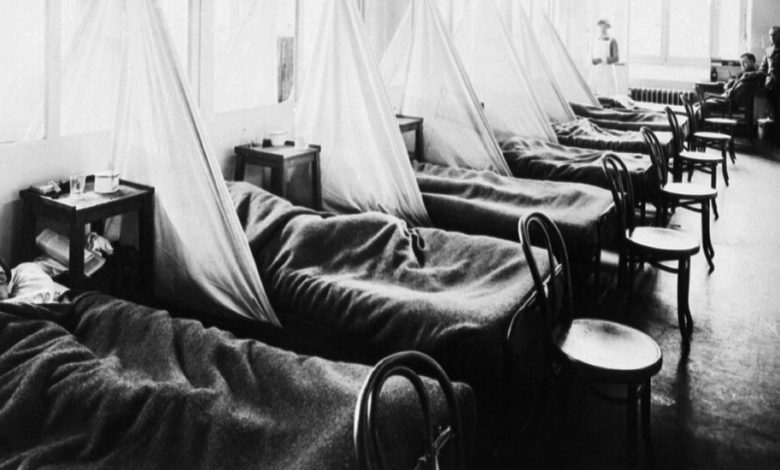Skeletons of 1918 Flu Victims Reveal Clues About Who Was Likely to Die

The flu typically kills the very young, the old and the sick. That made the virus in 1918 unusual, or so the story goes: It killed healthy young people as readily as those who were frail or had chronic conditions.
Doctors of the time reported that, among those in the prime of their lives, good health and youth were no protection: The virus was indiscriminate, killing at least 50 million people, or between 1.3 and 3 percent of the world’s population. Covid, in contrast, killed 0.09 percent of the population.
But a paper published on Monday in the Proceedings of the National Academy of Sciences challenges that persistent narrative. Using evidence in skeletons of people who died in the 1918 outbreak, researchers reported that people who suffered from chronic diseases or nutritional deficiencies were more than twice as likely to die than those who did not have such conditions, no matter their age.
The 1918 virus did kill young people, but, the paper suggests, it was no exception to the observation that infectious diseases kill frail and sicker people most readily.
Sharon DeWitte, an anthropologist at the University of Colorado, Boulder, and an author of the paper, said the finding had a clear message: “We should never expect any nonaccidental cause of death to be indiscriminate.”
The analysis of skeletons, said J. Alex Navarro, a historian of the flu pandemic at the University of Michigan, makes for “a fascinating paper and a very interesting approach to studying this issue.”
The lead author of the paper, Amanda Wissler, an anthropologist at McMaster University in Ontario, said she was intrigued by claims that the 1918 virus killed young and healthy people as readily as those with pre-existing conditions. In those days, there were no antibiotics or vaccines against childhood diseases, and tuberculosis was widespread among young adults.
There was a puzzle about who died from that flu, though, which helped fuel speculation that health was no protection. The flu’s mortality curve was unusual, shaped like a W. Ordinarily, mortality curves are shaped like a U, indicating that babies with immature immune systems and older people have the highest death rates.
The W arose in 1918 because death rates soared in people aged from about 20 to 40, as well as in babies and older people. That seemed to indicate that young adults were extremely vulnerable and, according to numerous contemporaneous reports, it did not matter if they were healthy or chronically ill. The flu was an equal opportunity killer.
In one report, Colonel Victor Vaughn, an eminent pathologist, described a scene at Fort Devens in Massachusetts. He wrote that he had seen “hundreds of young men in uniforms of their country, coming into the wards in groups of 10 or more.” By the next morning, he added, “the dead bodies are stacked about the ward like cord wood.”
The influenza pandemic, he wrote, “was taking its toll of the most robust, sparing neither soldier nor civilian, and flaunting its red flag in the face of science.”
Dr. Wissler and Dr. DeWitte, who have done similar research on the Black Death, saw a way to test the hypothesis about young people. When people have had lingering illnesses like tuberculosis or cancer, or other stressors like nutritional deficiencies, their shin bones develop tiny bumps.
Assessing frailty by looking for those bumps “is quite legitimate” as a method, said Peter Palese, a flu expert at the Icahn School of Medicine at Mount Sinai.
The researchers used skeletons at the Cleveland Museum of Natural History. Its collection of 3,000 people’s remains, kept in large drawers in a massive room, includes each person’s name, age of death and date of death.
Dr. Wissler said she treated the remains “with great respect,” as she examined the shin bones of 81 people aged 18 to 80 who died in the pandemic. Twenty-six of them were between the ages of 20 and 40.
For comparison, the researchers examined the bones of 288 people who died before the pandemic.
The results were clear: Those whose bones indicated they were frail when they got infected — whether they were young adults or older people — were, by far, the most vulnerable. Many healthy people were killed, too, but those who were chronically ill to start with had a much greater chance of dying.
That makes sense, said Dr. Arnold Monto, an epidemiologist and professor emeritus at the University of Michigan’s School of Public Health. But, he said, although the new study makes “an interesting observation,” the skeletons were not a random sample of the population, so it can be difficult to be specific about the risk that came with frailty.
“We are not used to fact that younger healthy adults are going to die,” which often occurred in the 1918 pandemic, Dr. Monto said.
Dr. Palese said there was a reasonable explanation for the W-shaped mortality curve of the 1918 flu. It means, he said, that people older than 30 or 40 had most likely been exposed to a similar virus that had given them some protection. Younger adults had not been exposed.




